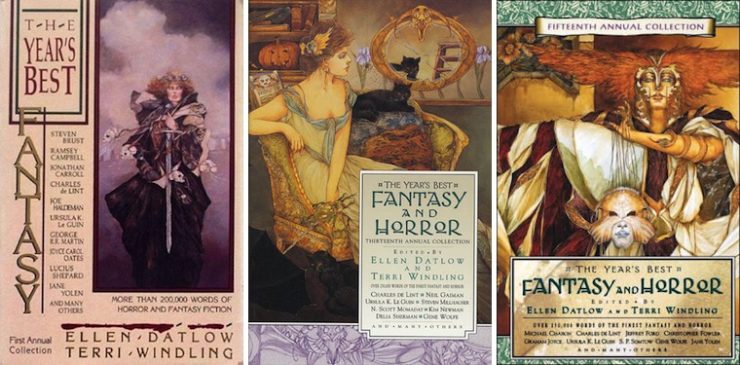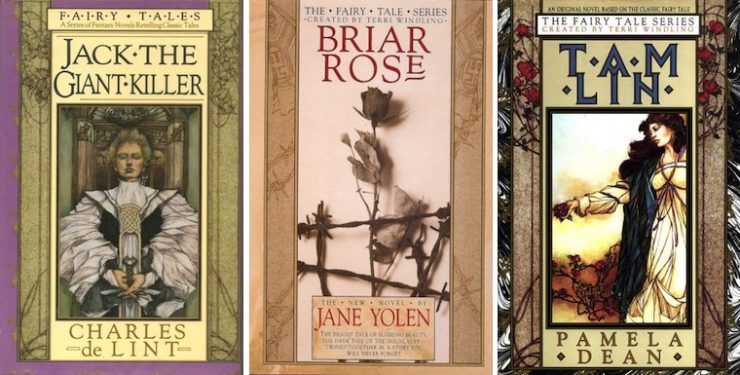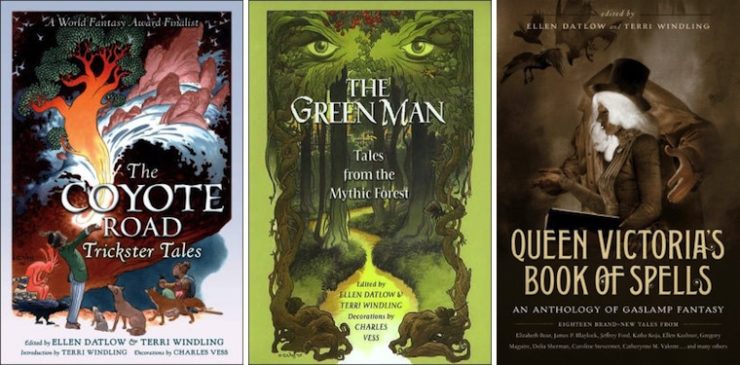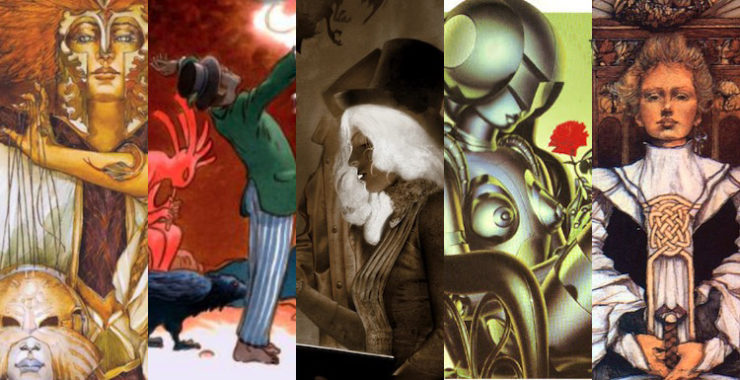It is difficult to overestimate the tremendous value of editors. The contributions that authors make to their respective fields, and their impact on the readers that encounter their work, can’t be overstated either, of course—but it is equally important to remember that no truly great author goes it alone; there are always strong editors behind the scenes, shaping the individual stories themselves as well as the publishing world at large. The Hugo Awards are named for an editor, after all.
Yet I can count most of the editors I recognize by name on one hand. Even with such a limited group to choose from, only two have had an extremely significant, identifiable impact on me as a reader: Terri Windling and Ellen Datlow. I could never hope to cover everything the two have contributed to the publishing world—their careers have stretched too far and are too varied and far-reaching for me to do them full justice. However, there are several projects that are worth looking at in order to appreciate their impact and get a sense of how influential their work has been, and continues to be.
Windling* and Datlow have had an editorial partnership spanning over three decades, and their names, for me at least, have stood as markers of quality for much of my reading life. From the time I first discovered their Year’s Best anthologies, I have looked to them as arbiters of the very best in genre storytelling. Now, it’s quite possible that I’m making a gross generalization based on my own limited experience (it’s been known to happen) but, despite winning several prestigious awards, Datlow and Windling are quite possibly two of the most recognizable editorial names in modern fantasy and horror, and yet I see little aside from a few occasional interviews that give them the credit they deserve. Jeff and Ann VanderMeer might be giving them a run for their money in the coming years for the title of Most Famous Editing Pair in Speculative Fiction, but Datlow and Windling have a significant head start on their side.

Datlow and Windling are perhaps best known as the editing team behind The Year’s Best Fantasy and Horror anthologies published from 1987 to 2003 (Windling left the project in 2003; Datlow continued through 2008). These anthologies were amazing not just because they provided a stellar collection of stories that highlighted each year’s most talented writers, but because they also expanded the boundaries of the fantasy and horror genres to encompass more than the traditional forms readers had come to expect. They often included magical realism, urban fantasy, weird fiction, and many other subgenres that were either just emerging or dismissed as too “literary” at the time.
It’s also vital to note that for readers, these anthologies were more than just collections of (really excellent) short fiction: they were also compendiums of knowledge encompassing all things fantasy and horror, from films and comics to television and magazines. The beginning of each volume, often stretching over a hundred pages or more, offers a roadmap to the major publishing and media events of the year, including incisive commentary that demonstrates just how fully immersed these two editors are in their genres of choice. As someone who discovered fantasy through the library rather than through other a community of other readers (and without regular recourse to the internet until much later), these summations gave me a sense of what was happening in the larger world of genre fiction—something that had always felt rather static and abstract until I was able to see how much happens in just a year, in a larger context.
One reviewer of the 13th Edition summed it up rather succinctly: “you can’t page through this volume without realizing how vibrant this field really is.” Recently, I’ve gone back through that same edition (published in 1999) and learned things I can’t believe I missed before. For instance, how on Earth did I not know that the English-language script adaptation of Princess Mononoke, one of my favorite movies of all time and my own personal gateway anime, was written by none other than Neil Gaiman?! This particular edition came out the year I would have seen the movie, and paging back through that volume now feels like opening a time capsule into my earliest days as a budding genre fan.

In terms of their partnership, each editor has a specialty—Ellen Datlow focuses more on horror while Terri Windling’s wheelhouse is fantasy—yet rather than simply taking a divide-and-conquer approach, their work illuminates and explores the relationship between fantasy and horror. Fantasy and science fiction are so often and automatically lumped together that it can be easy to overlook how much DNA fantasy and horror really share…something that becomes even clearer when you look at another anthology series the two produced, beginning with Snow White, Blood Red in 1993.
Anyone with even a passing interest in fairy tales knows that many of the versions we encounter today have been sanitized over the years and rebranded as children’s stories. Disney has become the most famous bowdlerizer of fairy tales, but the genre in general has been steadily transformed since the 19th century—something Terri Windling highlights at the start of her introduction to Snow White, Blood Red. In that intro, she makes clear that the intent of the collection (and eventual series) she and Datlow had undertaken is not to simply update old stories with modern flourishes but to recapture the original darkness of fairy tales, bringing them back to the adult audience that has forgotten their once-considerable power. As with the Year’s Best anthologies, Datlow and Windling focus on their respective areas of genre expertise. Unlike those broader anthologies, however, the fairy tale collections don’t ever feel like the two separate genres are sitting side-by-side, but are united in one vision, despite the deliberate split in the title (a convention that carries through the rest of the series).
It is through these collections that I first discovered the pleasures of stories based on well-known tales told through new, startling perspectives, and found that retelling older stories has a special kind of magic when done well. These books are also where I first discovered Tanith Lee and Jane Yolen, two writers whose work has long been a part of my own personal canon in fantasy. Each of the seven volumes they eventually produced together—ending with Black Heart, Ivory Bones in 2000—contains some of the most compelling (and often disturbing) versions of fairy tales I have ever encountered and nearly all of them hold up beautifully.

Speaking of retellings that hold up remarkably well, Terri Windling is also the editor of the “Fairy Tale” series, a handful of novels written by authors like Patricia C. Wrede and Charles de Lint that were published in the late 80s and early 90s. While this series was done without Ellen Datlow’s direct participation, I still find that I tend to mentally link it to their partnership. The fairy tale theme is, of course, the most obvious connection, but the novels also share an aesthetic link with their co-edited work thanks to the illustrator and designer Thomas Canty, who designed the covers for both the novel series and the fairy tale anthologies in his distinctive Pre-Raphaelite-inspired style. (Canty was also the designer and illustrator for the Year’s Best anthologies; it could be argued that much of the work I’ve mentioned so far might be considered a three-way collaboration in some ways). Despite the eternal injunction to never judge a book by its cover, I must confess that I probably discovered Windling and Datlow (and through them, many, many excellent writers) thanks to Canty’s artwork, which was less afraid to be overtly feminine than a lot of the more traditional fantasy artwork at the time, even if his style eventually became a bit overused.
I’ve yet to read every novel in the series, but definitely worth noting are Jane Yolen’s Briar Rose, which tells the story of Sleeping Beauty through the lens of the Holocaust, and Pamela Dean’s Tam Lin, based on the Celtic ballad of the same name (and a book that makes college life seem impossibly romantic). Whether these stories would have come into the world without Windling as editor is debatable given the talent of the writers, yet I am inclined to believe that her passion for the subject—and her ability to champion the most interesting versions of familiar stories—is at least partially responsible for their existence.
Ellen Datlow has also done quite a bit of solo work, but as I’m not personally much of a horror fan in general, the most notable anthology in my personal experience (outside of the Best Horror of the Year anthologies she currently edits) is the Alien Sex anthology, a science fiction collection published in 1990. I mean, how do you resist a title like that? I certainly couldn’t, and immediately bought it when I ran across an old paperback copy in a used bookstore a couple of years back. Though very different from fairy tales on the surface, the stories in Alien Sex prove that Datlow, like Windling, has always been interested in stories that do more than entertain, stories that dig deep into the human psyche and the more primal elements of our natures. In 1998, Datlow and Windling would revisit the murky waters of love and sex via the realm of myth and legend in their anthology Sirens and Other Daemon Lovers, a stellar collection of erotic fantasy that continues the boundary-stretching tradition of their partnership.

In an interview with Locus Magazine in June of 2016, Windling and Datlow discuss what makes their partnership work so well. Like any good creative and/or business arrangement, they know how to divide their tasks according to their strengths (and not just along genre lines). Windling, for example, writes many of their introductions and is frequently in charge of the table of contents (a task that takes more finesse than you might expect) while Datlow is often the one to deal directly with writers and take charge of organizational issues, prompting Windling to remark that Datlow “makes the trains run on time.” The fact that their joint projects feel so seamlessly put together is a testament to how well they make this arrangement work. Just like editing a story is more than polishing grammar and syntax, assembling an anthology is so much more than simply compiling a few good stories.
In that same interview, the two discuss their process of choosing stories for various collections, sharing how, after combing through hundreds of possibilities, each potential choice much stand up to another half-a-dozen rereads before it can be accepted. Windling also outlines how the stories are arranged, a meticulous process with each story placed in the perfect orientation with the others to allow them to inform, echo, and bounce off each other. Operating on a level beyond a simple assemblage of stories, the anthologies Datlow and Windling create are treated like an artform all their own.
I’ve spent a lot of time discussing these two influential editors without mentioning what is, to me, one of the most salient points to consider: they are both women. The fantasy and horror genres, like science fiction, are still considered to be largely male-dominated fields. Windling and Datlow have been collaborating and collecting together for over 30 years in these genres that are, despite many gains, still struggling to figure out how to redress the issues of sexism and exclusion that have plagued them from the very beginning. Windling and Datlow’s ability to make names for themselves in such a world—to be considered expert enough to compile collections that are a measuring stick of their respective genres—is certainly part of what makes their contributions significant. The other part is simply that they are damn good at what they do.

Like any good editor, Windling and Datlow rarely call attention to themselves. The introductions to their work are often about the broader cultural inspirations behind their choices and why the projects spark their particular interest, with a distinct focus on the writers and their contributions. Yet, as I sit here writing this, surrounded by over a dozen volumes emblazoned with their names (representing merely a fraction of their overall output), I can’t help but feel that Datlow and Windling’s efforts have made an undeniably wonderful, powerful impression on their corner of the publishing world. Their projects have expanded their respective genres to include a range of stories that may have languished outside of the prescribed boundaries of fantasy and horror; meanwhile they could also be credited with reintroducing the power of fairy tales to a whole new audience.
More recently, it seems that Datlow and Windling have turned their attention to subgenres and themed anthologies, from The Coyote Road (trickster stories) and The Green Man (forest tales) to Teeth (vampires) and After (post-apocalyptic stories). My own most recent acquisition, Queen Victoria’s Book of Spells, is a collection of gaslamp fantasy published in 2013 that, much like their other work, feels ahead of its time as it plumbs the darker depths of a subgenre that has too often been consigned to the realm of lighthearted romps and children’s stories.
With such a massive catalog of volumes produced both together and apart, I may spend the rest of my life trying to catch up and read all of the stories Ellen Datlow and Terri Windling keep collecting and compiling so brilliantly—and as a devoted reader of their work, I couldn’t be happier about that prospect.
*It’s well worth noting that Terri Windling is a successful author, essayist, and artist as well as an editor, but that’s a conversation for another time!
Amber Troska is a freelance writer and editor. When she isn’t reading, you can find her re-watching Stranger Things again.











I admit I didn’t often read much (in some cases, any?) of the fiction in those Year’s Best anthologies, but the editorial matter alone was more than worth the price of admission.
And I still treasure my fairy tale anthologies and novels, especially the ones with Thomas Canty covers.
No mention of the Bordertown books at all? Even if they weren’t bestsellers, they’ve had a huge influence on readers and writers in the genre.
Yes, yes, and yes. These two women changed my life. I am positive I would be a different person if I hadn’t stumbled upon their Fantasy and Horror anthologies with recommended reading at the front. I cannot imagine my life without the magic of Charles de Lint, Graham Joyce and Patricia McKillip, just to name a few authors who helped form my inner world. An artist myself, I am also a huge fan of Terri Windling’s, “The Wood Wife”. It never fails to inspire.
The “Year’s Best” and “Fairy Tale” series were a bit before my time, but what I really remember Datlow and Windling for were the YA mythic fiction anthologies: The Green Man, The Faerie Reel, The Coyote Road, and The Beastly Bride, all of which I still occasionally crack now and then. Of course they were able to get incredible authors for each book, but what really got me was how they managed to tie myth into reality so well, creating a heightened but almost plausible version of the world. The Green Man in particular is one of my favorite books – it really got at the heart of why I’m a nature lover.
And @xaaronx totally agree with you about the Bordertown books (I felt like such a punk reading them!). I don’t know how much of Datlow’s beast it was, though – I think Ellen Kushner was more involved, alongside Windling.
You’re correct, holt, I wasn’t at all involved in the Borderlands books. It was Terri and Mark Arnold, then Terri and Ellen Kushner.
I read the Year’s Best just for the recommendations.
I adored the Snow White, Blood Red anthologies, and I kept looking for more of them long after the publication of Black Heart, Ivory Bones. (Ditto Windling’s Fairy Tale books.) I’ve been gradually picking up the Year’s Best anthologies as I come across them.
Another anthology I loved – difficult though it was to read at times – is Windling’s The Armless Maiden: And Other Tales for Childhood’s Survivors. It includes stories, poems, and essays that use fairy tales as a way of exploring and processing child abuse. It’s remarkable and often brutal.
Thank you for this. I have long been a fan of the “Year’s Best” series, discovering it around volume 6 and buying every volume from then forward (and going back to collect the first 5). I devoured (and treasured) each volume and often found new writers from the recommendations found in the front section (year’s review). These still sit on the top shelf of my bookcase in a position of pride (indicative of the fact that they have a position of pride is that the Robert Jordan Wheel of Time series is on shelf two [and part of three]).
I did read the Snow White, Blood Red series as well. And treasured them.
I think what particularly appealed to me about the series is the recognition that fantasy and horror are really two sides of the same coin (seeing speculative fiction as more than a collection of genres). The best stories (and they always seemed to find the best ones) had that special moment of genre crossing where the elements of light fantasy seemed tripped up by the tropes of darker matter. I relished in those cross-boundary liminal moments, and I thank you for this illuminating insight into Datlow and Windling’s work. I miss the annual tradition of cracking open a new collection.
I love this article so much. I devoured all of their anthologies in college (I truly miss the Waldenbooks in the mini-mall in downtown Fairbanks) and will read any author recommended by either of these ladies. I can’t count the number of favorite authors I discovered because of them.
Every one of these volumes needs to get an eBook release. I missed several over the years and going back through the ones I have to find missed gems is wonderful.
The fairy tale series do. The YBFH is virtually impossible because of all the individual rights involved. I know our packager, Jim Frenkel was trying for a long time to get e-rights for the first volume. I don’t think he succeeded.
Echoing hoopmanjh, I would read the stories selectively, but always always read the introduction. I can look back at old journals and see lists of fantasy novels, and in many cases anthologies (in particular After the King:Stories in Honor of J.R.R. Tolkien) to read that I compiled from the intros of a particular year. I greatly missed those lengthy year-in-reviews once the new editors (as good as they were) succeeded the Terri/Ellen partnership.
Thank so much for this article, Amber!
Those lengthy year-in-reviews were always included throughout the whole run of the series. Gavin Grant and Kelly Link continued them, And or course, so did I with regard to the horror half of each volume.
I have recently gotten the first four volumes of YBFH in paperback. I have read several stories out of the first volume. While most of them where not to my taste it still amazes even back in the late 80’s Windling and Datlow were actively pushing the envelope with what kind of story is fantasy or horror. They have championed a more literate style of writing style over the traditional pulp one.Also they have pushed the community into seeing that allowing more varied voices to be heard enriches the field rather then diminishes from it. The entire modern field of speculative fiction owes a debt of gratitude to these two trailblazers.
Totally memory system fail regarding my previous remark on the post-Winding editions. Last night I read, for the first time in a while, Gavin and Kelly’s intro to the 17th edition (the first one they worked on with Ellen Datlow). I discovered one of my all-time favorite novels, K. J. Bishop’s The Etched City, from their year in review.
New project: Read each year in review summation from the first edition to the final one (1987-2008).
All those stories and all those anthologies made me the person I am today. Stuck in a little backwater town in Alaska, they opened my world and showed me that there was more out there than country music, beat up pickups, and guns. They showed me how to dream, and for that I will be forever thankful.
I’m sure I’m not the only person who has bought anthologies and books solely because together or alone, these two women have edited or written them, right?
And yes, Thomas Canty’s distinctive artwork is yet another element that cannot be dismissed. Amazing work all around.
I’ve bought every book they edited together. Every one. And read them cover to cover. I used their “Year in ” essays in the Year’s Best anthologies to read as many of their recommended authors and novels as possible. I trusted them and they gave me so many experiences I’d never have had on my own, and they never let me down, even if I wasn’t so fond of a story or two. I hope they’re proud of the work they’ve done, because they should be, if only because they showed this girl a universe of modern fantasy and horror that was quality all the way down.
I, too, have and still happily purchase anything with either Windling or Datlow attached. Especially if there is any sort of commentary on the stories. Through their anthologies I have found several new favorite authors as well.
Wow, wow, wow. Phenomenal article! I ‘d obviously heard of Datlow and Windling, but I had no idea that they’d worked together almost exclusively, and for so long, and just how well they work together. Based solely on Datlow ‘s reputation, I would not hesitate in reading any of their publications, solo or as a duo.
Phenomenal article! I ‘d obviously heard of Datlow and Windling, but I had no idea that they’d worked together almost exclusively, and for so long, and just how well they work together. Based solely on Datlow ‘s reputation, I would not hesitate in reading any of their publications, solo or as a duo.
Thank you for sharing!
Hi! Long shot, but I want to hire Tom Canty for a commission. Anyone have his email address? He doesn’t seem to have much of an internet presence! Cheers!
He’s on facebook.